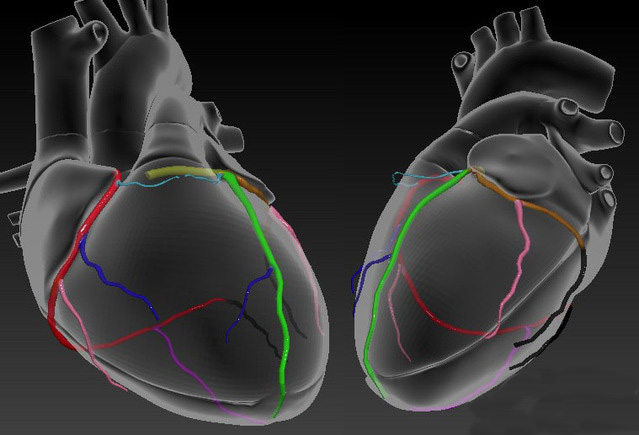Now, we've talked about the direction of flow,
我们介绍了血液流向的问题
we've talked about the fact that one side carries more oxygen than the other,
介绍了动脉血中的氧气要比静脉多
and we've also talked about the fact that the arteries are high pressure-low volume system.
同时也讲到了动脉是高血压,低血量的
And the veins are high volume-low pressure system.
对应的,静脉则是低血压,高血量
So what are some other differences?
还有什么不同点呢?
So, one other difference is that in the arteries, you actually don't have any valves.
还有一点,动脉中,不存在瓣膜
Now --I don't know how to label that to make it super clear,
这个不太好做标记
but let me just find some sort of open spot here,
在一个好标记的地方写一下
and write number four, there are no valves in the arterial system,
第四个不同点,动脉中没有瓣膜
whereas on the venous side, you actually do have valves.
而静脉中存在瓣膜
You have these valves come together
瓣膜就像这样
actually make it, let me make it very clear, but making the two sides touch.
我们画成两边是接触的状态
And the blood kind of goes through like that.
血液就像这样通过
So you have these valves keep the blood going in the right direction.
这些瓣膜的存在是为了保证血液的正常流动
So that would be the fourth point of difference between the two.
这是动脉和静脉的第四个不同点
So you have these valves.
就在于瓣膜

And you might get confused, because you think, "well, doesn't the heart also have valves?"
大家可能要问,心脏里不是也有瓣膜吗?
And it does, the heart also has valves.
心脏中确实是有瓣膜的
But the veins have a different type of valves, and that's actually keep the blood flowing in the right direction
但静脉中的瓣膜与那个瓣膜是不同的,既然瓣膜的存在
You can imagine that you probably don't even need that on the arterial side,
是为了确保血液流动的方向正确,那么动脉中是不需要瓣膜的
because the pressures are so high, that the blood is forced to go one way.
因为动脉中血压很高,血液流向只可能向一边
Or, as in the veins, because it's kind of like a giant lake.
而在静脉中,就像一大片湖
Water can kind of swirl around and around and around,
湖水中可能存在漩涡
and so it's helpful to have valves keeping going in the right direction.
所以需要瓣膜来确保流向的正确性
So that's the fourth point of difference.
这就是第四个不同点
So now think about the fact that you might have, a break in the arterial system.
下面大家想象这样一种情况,就是动脉出现了断裂
So let's say that you have an accident, and you cut an artery --or, a big artery, let's say.
假设有一起事故切断了大动脉
What would it look like? So if you have a break right here,
那会是什么样子呢?假设切断了这里
you would actually have like a fountain of blood, coming out, right there.
血液会喷涌而出,从这里喷出来
Because it's under such high pressure, that it's gonna spew up, right.
因为血压很高,血液会喷射出来
And so this is basically what it looks like when you actually cut your artery,
一旦切断动脉,差不多就是这样
again, because of the fact that it's under such high pressure.
这是因为动脉内血压过高
And now on the venous side, on the vein side, if you have a break. It looks really different.
而在静脉中,如果血管切断,情况是很不一样的
Because you have --let's say your break is right here,
假设在这里血管出现断裂
you'd actually get a kind of --a pool of blood, just locally, before it clots off.
在血液结块之前,可能会出一部分血
Because again, you have a very low pressure.
这是因为血压很低
So it's just gonna kind of quietly pool and, you might get a bruise right there.
所以流出一部分血之后,可能只会有一个瘀斑而已
But it's really won't look like a fountain of blood.
并不会喷血
And that's actually another final point of difference which,
这是动脉和静脉的最后一个不同点
really gets back to the high pressure system on the arterial side and the high volume-low pressure system on the venous side.
归根到底还是因为动脉中血压高,而静脉中血压低












